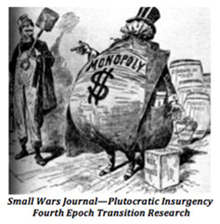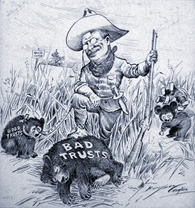"All of us who care about the future of Planet Earth must be grateful to Vandana Shiva. Her voice is powerful, and she is not afraid to tackle those corporate giants that are polluting, degrading and ultimately destroying the natural world." ~Jane Goodall, UN, Messenger of Peace
Source: Small Wars Journal
Research Guide: Plutocratic Insurgency - The Gilded Age Redux
Robert J. Bunker | Tue, 03/13/2018
Plutocratic insurgency represents an emerging form of insurgency not seen since the late 19th century Gilded Age. It is being conducted by high net worth globalized elites allowing them to remove themselves from public spaces and obligations—including taxation—and to maximize their ability to generate profits transnationally. It utilizes 'lawyers & lobbyists' and corruption, rather than armed struggle—though mercenaries may be employed—to create shadow governance in pursuit of plutocratic policy objectives. Ultimately, this form of insurgency is representative of the challenge of 21st century predatory and sovereign-free capitalism to 20th century state moderated capitalism and its ensuing public welfare programs and middle class social structures. It can be viewed as a component of ‘Dark Globalization’ that, along with the emergence of criminal insurgency, is now actively threatening the public institutions and citizenry of the Westphalian state form. ~ Plutocratic Insurgency Notes, Small Wars Journal
This research guide has been created for Small Wars Journal readers to aid in their understanding of the plutocratic insurgency construct and explain how it is related to the earlier criminal insurgency construct which has been the focus of numerous El Centro works over the last decade. The plutocratic insurgency concept dates back to 2011 and has been influenced by earlier work done by John Robb (Onward to a Hollow State, 2008) and Nils Gilman (Deviant Globalization, 2010). As a theoretical construct, it was further inspired by the global street protests and demonstrations of the Occupy movement taking place during that period. Research on this topical area for its U.S. national security threat potentials has been conducted related to U.S. Department of Defense and Army programs, with a number of works produced or derivative of these efforts; Op-Ed: Not Your Grandfather's Insurgency (2014), Global Criminal and Sovereign Free Economies and the Demise of the Western Democracies (2014), and Old and New Insurgency Forms (2016). Of these works, the "Foreword: The twin insurgency—facing plutocrats and criminals" written by Nils Gilman for the derivative 2014 edited book project—and reprinted online as The Twin Insurgency in The American Interest—is by far the best known and eloquent of these writings:
The defining feature of the plutocratic insurgency is its goal: to defund or de-provision public goods in order to defang a state that its adherents see as a threat to their prerogatives. (Note that, conceptually, plutocratic insurgencies differ from kleptocracies; the latter use the institutions of state to loot the population, whereas the former wish to neutralize those institutions in order to facilitate private-sector looting. In practice, these may overlap or co-mingle.) Practically speaking, plutocratic insurgency takes the form of efforts to lower taxes, which necessitates cutting spending on public goods; reducing regulations that restrict corporate action or protect workers; and defunding or privatizing public institutions such as schools, health care, infrastructure, and social space.The rise of a new plutocratic class in American society, as well as growing economic inequality in our country, and the increasing power of multinational corporations to the detriment of sovereign states have all been identified and commented upon by numerous scholars including David Rothkopf (Superclass, 2008 and Power, Inc., 2012), Chrystia Freeland (Plutocrats, 2012), David Grusky and Tamar Kricheli-Katz, eds., (The New Gilded Age, 2012), Dennis L. Gilbert (The American Class Structure in an Age of Growing Inequality, 2014), Thomas Piketty (Capital in the Twenty-First Century, 2014 and The Economics of Inequality, 2015), and Ronald Formisano (Plutocracy in America, 2015 and American Oligarchy, 2017).
Such a new class of powerful economic elites has not been witnessed since the historical Gilded Age and in some ways can be likened to the smart and talented winners of a large MonopolyTM game—one that has taken place not only within American society but also transnationally within the larger global economy that has developed. Major differences, of course, are that, unlike a traditional MonopolyTM game, this one never ends. The participants who lost do not get a restart and—since the stakes are exceedingly high, with individual and family livelihoods and futures on the line—cheating and other underhanded tricks are commonly used to ensure success. The new class of plutocrats that has emerged has moved 'beyond the state' and does not need or require public goods or services such as education, health services, or police protection, preferring to purchase such commodities on the open market. They seek economic impunity of action with no obligations to the state including paying taxes and, at times, even suffering the burdens of citizenship and would rather live separate (and unequal) lives to those of the common lower socio-economic members of the public.
It took the full weight of the U.S. Federal government, the muckrakers (reformist journalists), and engaged citizens to eventually tame the historical Gilded Age plutocrats. This was done over some decades through a process of trust-busting (initiated during the Roosevelt and Taft presidential administrations), newspaper exposes and shaming, anti-corruption campaigns, and ultimately robust income tax and estate tax levees to ensure that a network of aristocratic families did not come to dominate all aspects of American society. From the 1930s well into the 1970s, the plutocratic class had been relatively contained with it once again beginning to slowly emerge and then build in strength from the 1990s and beyond. This time around, however, the newly ascendant plutocratic class may not be as easy to tame, for it now exists well beyond the domestic U.S. economy and has powerful criminal confederates as allies.
The Taming of the Plutocratic Trusts by Teddy Roosevelt
Plutocratic insurgency can be placed 'in strategic context' when juxtaposed with John Sullivan's criminal insurgency concept which dates back to 2008. Both concepts, in turn, draw upon Steve Metz's brilliant postulation of the commercial insurgency form in 1993—although as a bi-furcation of that proposed form into the lower (criminal) and upper (plutocratic) socio-economic components of the burgeoning global political economy. The fusion of these two concepts—which yielded Nils Gilman's before-mentioned twin insurgency work as a descriptive introduction to the post-modern epochal transition now taking place—provides a powerful lens into evolving elements of early 21st century dark (i.e. deviant) globalization.
A visual representation of the compression effect of the underworld of criminality pushing up into the "Goldilocks Zone" inhabited by the Western Democracies—one defined by a strong middle class, a viable legitimate (state-moderated) economy, conventional warfare, and sovereign rights—and the upper-world of sovereign free entities pushing down on it can be viewed in Figure 1. Variations on this figure have existed since 2011 and have been utilized in various briefings and presentations to diverse academic, governmental, and military and law enforcement audiences. As we increasingly enter into the epochal transition from the modern to the post-modern era, it is projected that the compression effect will become increasingly pronounced. Loss of liberal democratic leadership in the world along with a concurrent rise in non-state radicalism and state authoritarianism will progress. As the Westphalian state form perceives itself besieged, it will likely over-centralize its decision-making functions and institutional processes, exacerbating this cycle.
Please go to Small Wars Journal to read the entire article.
________
In Oneness vs 1%, Vandana Shiva takes on the billionaires club of Gates, Buffett, Zuckerberg and other modern Mughals whose blindness to the rights of people and to the destructive impact of their construct of linear progress, have wrought havoc across the world.
Oneness VS.. The 1%
Plutocratic insurgency represents an emerging form of insurgency not seen since the late 19th century Gilded Age. It is being conducted by high net worth globalized elites allowing them to remove themselves from public spaces and obligations—including taxation—and to maximize their ability to generate profits transnationally. It utilizes 'lawyers & lobbyists' and corruption, rather than armed struggle—though mercenaries may be employed—to create shadow governance in pursuit of plutocratic policy objectives.
Plutocratic Insurgency Reader
Related:
Investors Were Being Blocked from Fund Withdrawals Months Before the Pandemic
Banks Run These Systems Not Governments - BlackRock Serves the Wealthiest 10 Percent - "Sea of Organized Crime" - Unlimited Quantitative Easing - Money Has No Meaning - The Popsicle Index - Corporate Monopolization of Power
The Oligarch Takeover of US Pharma and Healthcare – And the Resulting Human Crisis
Look What Happened When You Were Distracted With the Coronavirus Operation - "An Extremely Dangerous Company" - Danger Ahead
Vaccination: how the West invades the world


No comments:
Post a Comment
Note: Only a member of this blog may post a comment.